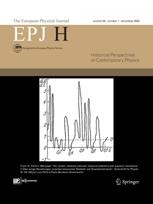Mid-twentieth-century physics in the home of Galileo
Breakthroughs made at the Institute of Physics near Florence before 1950 include Fermi statistics and the first electronic coincidence circuits
New York | Heidelberg, 15 February 2023
 Florence was a flourishing centre for fundamental physics research throughout most of the twentieth century. Roberto Casalbuoni, Daniele Dominici and Massimo Mazzoni – all physicists currently working there – have reviewed the history of the city’s Institute of Physics for the journal EPJ H: Historical Perspectives on Contemporary Physics, concentrating on the important decades of the 1920s to 1960s.
Florence was a flourishing centre for fundamental physics research throughout most of the twentieth century. Roberto Casalbuoni, Daniele Dominici and Massimo Mazzoni – all physicists currently working there – have reviewed the history of the city’s Institute of Physics for the journal EPJ H: Historical Perspectives on Contemporary Physics, concentrating on the important decades of the 1920s to 1960s.
The Institute, established at the beginning of the century, was considerably strengthened under the leadership of Antonio Garbasso, who served as Mayor of Florence for a time in the early 1920s. Garbasso is now considered one of the fathers of modern Italian physics, but he was also an effective administrator who formally established the University of Florence and secured funding for a new physics laboratory at Arcetri outside the city. This attractive building was located close to where Galileo had lived during his last years.
The group of brilliant young physicists known as the Arcetri School that was established at the Institute in the 1920s included some who are now almost household names: the best known, probably, being Enrico Fermi. This group stayed together for over a decade, until its members were offered chairs elsewhere or left for political reasons.
The research of the Arcetri School was largely focused in the areas of quantum mechanics and cosmic rays. Fermi was based in Florence when he derived the quantum-mechanical principle of Fermi Statistics (also known as Fermi-Dirac Statistics), without which modern electronics could not have been developed. Another member of the School, Bruno Rossi, invented the first electronic coincidence circuits to record pulses from Geiger counters; these formed the basis for all subsequent counter experiments in particle and cosmic ray physics.
The Institute continued to flourish after the war, with former students setting up their own groups in the areas of nuclear, elementary particle and finally theoretical physics. This last discipline has been particularly strong in Florence since the late 1950s, when Raoul Gatto arrived. He established an Italian school of theoretical physics in Arcetri, and groundbreaking work continues there today in the Galileo Galilei Institute of Theoretical Physics.
References: Casalbuoni, R., Dominici, D. & Mazzoni, M. A brief history of Florentine physics from the 1920s to the end of the 1960s. EPJ H 47, 15 (2022). https://doi.org/10.1140/epjh/s13129-022-00048-7
Further Information
For more information visit: www.epj.org
Services for Journalists
The full-text articles are available here.
Contact
Sabine Lehr | Springer | Physics Editorial Department
tel +49-6221-487-8336 | sabine.lehr@springer.com
